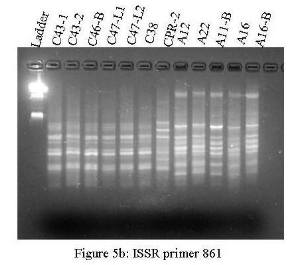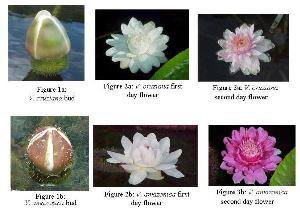 |
in breeding lineages of Victoria cruziana and V. amazonica
(1)Lake Forest College, Lake Forest, IL 60045 (2)Chicago Botanic Garden, 1000 Lake Cook Rd., Glencoe, IL 60022
Background
South America is home to a number of rare and unique species, many of which we are losing to habitat destruction. Water lilies have been referred to as one of the most beautiful flowers on earth. The largest species are found in South America and belong to the genus Victoria, so named to honor Queen Victoria. The genus comprises of two species Victoria cruziana and Victoria amazonica. The two species can be difficult to distinguish, except they are native to different areas of South America. Victoria cruziana is found in Paraguay, Uruguay, and Argentina, while Victoria amazonica is found in Peru, Colombia, Guyana, and Brazil. In 1961 Longwood Gardens' Patrick Nutt created the first hybrid cross with V. cruziana as the pod parent and V. amazonica as the pollen parent. The V. 'Longwood Hybrid' could survive cooler temperature and bloomed much earlier in the year; this allowed many other botanical gardens to include them in their collections. Dr. Ben Knotts and Kit Knotts are trying to produce a breeding population of both V. cruziana and V. amazonica. However, it has proven hard to determine if some of the specimens are pure lines or hybrids.
Difference in Victoria Species
Victoria cruziana and amazonica have a many similar characteristics, making them difficult to tell them apart. The younger the lily the more challenging it is to distinguish the two species. Still there are a number of characteristics which separate the two species.
Methods
Samples were collected from a variety of sites (table 1). The DNA was extracted using Fastprep DNA kit. A Polymerase Chain Reaction (PCR) was done testing ISSR primers. Spermine was used to purify the DNA. Of the hundred primers tested five were selected and tested on the samples, 807, 808, 809n 840, and 861.
Results and Discussion
We screened individuals which we knew to be true species,
using 100 ISSR primers. We selected five primers which gave banding
patterns with clear and repeatable differences between the two
species of water lilies. All individuals were scored for the
present and absence of up to 15 bands, 3 per primer. When we
scored the breeding lines of Victoria amazonica and V.
cruziana we found no evidence of hybridization, i.e. all
individuals showed banding patterns which clearly belonged to
one or the other species (fig. 5). This is strong evidence that
the breeding lines are true species and no hybridization has
occurred in these lines.
 Click to enlarge |
 Click to enlarge |
Conclusion
In order to breed these two different species of water lilies we should know if they are a pure breed or hybrid. By performing PCR we have successfully found a way to distinguish the difference between the two species. Using these ISSR primers we were able to show that breeding lines had no evidence of hybridization and did represent pure species lines. This technique could prove useful for future breeding programs.
|
|
